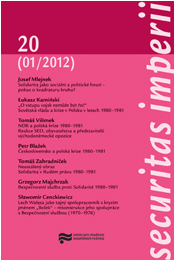Solidarita jako sociální a politické hnutí – pokus o kvadraturu kruhu?
Solidarity as a social and political movement – an attempt to square the circle?
Author(s): Josef MlejnekSubject(s): Crowd Psychology: Mass phenomena and political interactions, Post-War period (1950 - 1989), History of Communism, Socio-Economic Research
Published by: Ústav pro studium totalitních režimů
Keywords: Solidarnosc; social conditions; Poland; communism;
Summary/Abstract: On August 31, 1980, Solidarity was born. Attempts to define its phenomenon have shown that it is not susceptible to traditional classifications. For it was simultaneously a revolution, a great social movement, a national uprising, and – quite simply – a trade union. And it may well have been the world’s only trade union with a peak membership of 10 million, representing a cross-section of society and accounting for one-third of the whole 38-million population (not including children and the elderly). Solidarity was also assuming the role of the guarantor of renewal of many spheres of life in Poland, of economic reforms, eradication of injustice, curbing of lawlessness and abuses by the communist apparatus of power, and of restoration of the truth in the mass media and schools. It became a movement for the reclaiming of civic rights and national traditions. Solidarity was a pacifist movement, whose program rejected violence as a means of resolving collective disputes. It operated on a national scale, invoking the principles of social solidarity and moral values in public life. By its very nature it contradicted the rules of the communist system – thus eroding the foundations of communism in Poland, and later – throughout the entire Soviet bloc.
Journal: Securitas imperii
- Issue Year: 2012
- Issue No: 20
- Page Range: 14-35
- Page Count: 22
- Language: Czech

